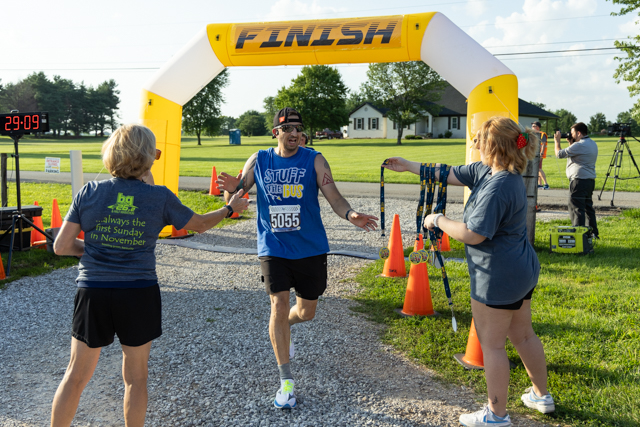Tracking crappie in Kentucky Lake
Published 12:00 am Sunday, July 6, 2003
Kentucky Lake is renowned for its tremendous crappie population, and each spring anglers from all across America head to the Big Pond to sample fishing for slab crappie. Some notice that the crappie fishing is a bit different than a few years ago mainly the catch is a tad smaller, but there may be more subtle changes taking place. Kentucky Department of Fish and Wildlife Resources biologists are studying to see if changes in the lake itself are causing some changes in the crappie populations. There are two main species of crappie in Kentucky Lake black crappie and white crappie. White and black crappie have minor but significant behaviors and habitat preferences. KDFWR has launched a project to see if a lack of angler knowledge about the preferences of black crappie may be attributing to the number of fish caught. It may be that because the black crappie are slightly different, anglers catch fewer of them when using the known techniques for catching white crappie. KDFWR began the study this spring when it loosed 30 white and 30 black crappie with radio transmitters to track them through their spawn and into the summer. The movement patterns may show distinct differences in behavior regarding responses to weather and water changes such as clarity, level and flow. It is already known that black crappie prefer clearer water with gravely bottoms, and will spawn in deeper water slightly earlier than white crappie. This fact alone could have an effect on angling tactics and contribute to the overall ratio of fish harvested. A caution and requests from the KDFWR are that any radio-equipped crappie which each have a 12-inch long, thin wire extending from the ventral side be immediately released. KDFWR asks fishermen to call the telephone number on the tag if the crappie does not survive. A total of 750 white and 750 black crappie were also tagged with a small yellow tag near the base of the dorsal fin and released to determine angler catch rates. A reward will be given for the return of each tag. There is a phone number on the tag to call, or you can use a return envelope available at many of the marinas and bait shops around the lake. This study is for the sake of all anglers, the department message says, but we cant learn anything if the tagged fish get caught. If we get the tag back we can reimplant it into another crappie. But it will be best to just release the crappie if you catch one. Biologists will also be studying the feeding patterns and prey of the two species of crappie to see if there are significant differences. In addition to annual creel surveys on Kentucky Lake, some identified anglers will be keeping a diary of trips and catches throughout the year. Diary information will show the ratio of white crappie to black crappie caught, and if there are differences in habitat of the two species. The final phase of the data collection will be some extra electro-fishing and netting in the spring to compare with annual fall netting data. According to KDFWR, this is what is known so far and some questions that can be answered through the current study: Prior to 1997, black crappie collected in trap nets made up only on average of 18 percent of the catch. More recent studies show black crappie make up, on average, 72 percent of the catch. Although trap-netting data suggest a change in species dominance, the 1998 creel survey did not change correspondingly, when black crappie made up 12 percent of the crappie caught and 17 percent of the harvest. Compared to the 1991 creel survey, black crappie made up 13 percent of the crappie caught and 16 percent of the harvest. So even though our trap nets were catching a higher percentage of black crappie in the late 1990s, anglers were still catching the same percentages of white and black crappie. In 2001, trap net studies revealed the crappie population had more than double the long-term average, but the majority of these fish were black crappie. This data suggests that the number of white crappie had declined, while the number of black crappie had greatly increased; yet KDFWR creel surveys suggested that very few anglers were catching black crappie. This is an important study that will help KDFWR help fishermen access an abundant resource. If the numbers of black crappie are increasing and nobody is catching them, then maybe a change in fishing methods is needed to adapt to the changing waters just as the fish populations have. You can help by reporting tagged fish and gladly sharing your success in the creel surveys. The work of nature is complex as sure as the subtleties of the great outdoors is ever-changing around us. Here is this weeks fishing reportLake Barkley: Largemouth are being taken shallow early and late along ledges and flats on topwater lures and are also active near grass beds and wood cover. Later in the day, fish are being taken on deep runners, Carolina rigged worms and lizards, and jigging pork rind in heavy cover. White bass have been good at the mouths of the bays, casting small spinners such as roostertails, small spoons and chuggers. Some jumps reported, but still scattered and brief. Bluegill are very active early and late near the brushes with willow flies hatches. Crickets and artificial flies do the trick. Barren River Lake: Bass are fair to good in the weed beds and on the main lake points and flats on plastic worms and deep running crank baits. Hybrid are still hitting on the main lake on the surface. Fish the top with swimming crankbaits, or deeper with spoons or troll live or artificial bait at 12- to 18-feet deep. Crappie are fair but scattered. Fish the brush 10- to 12-feet deep with minnows. Some activity has been reported night fishing under the lights around bridges and bluffs. Bluegill are good on crickets worms and flies around treetops and on riprap. Catfish are fair to good on trotlines on cut bait and live crawfish and minnows. Kentucky Lake: Bass are good on the main lake bars and points on shad raps and plastic worms at 4- to 15-feet deep. Crappie are fair over stumps and tree tops in 10 feet using minnows and jigs. White bass are fair to good trolling the flats some action in the jumps early and late. Nolin Lake: Black bass fair to good on top water in the early morning around wood structure. Carolina rigs with worms or lizards are working on points and shelves. Bluegill are good on artificial flies and live crickets along rocky banks and around docks. Catfish are fair to good, still fishing nightcrawlers along deep banks. Rough River Lake: Black bass continue to be fair to good, hitting on soft plastics and crankbaits off main lake points and along channels in coves. Crappie have been fair to good on minnows fished under bobbers in 12 feet of water near brush. Hybrids have been hitting spoons and shallow runners in the jumps. Bluegill are hitting crickets, mealworms, wax worms under the willows and brushes on the shorelines. Catfish have been taken in on cutbait, nightcrawlers and liver still fishing late in the afternoon and jugging at night.






